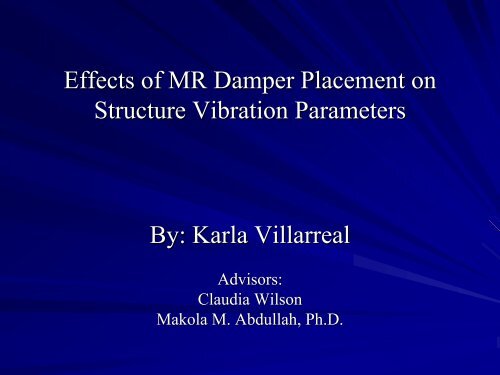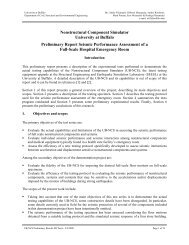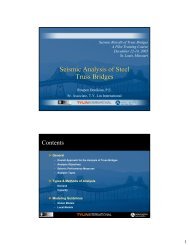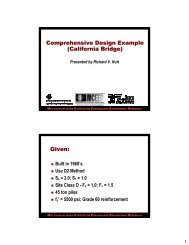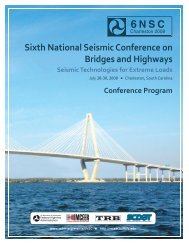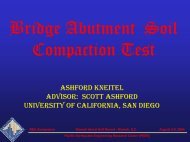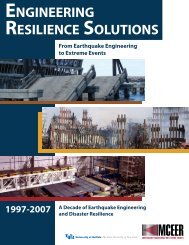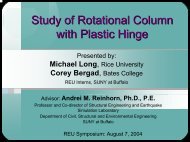Effects of MR Damper Placement on Equivalent Damping ... - MCEER
Effects of MR Damper Placement on Equivalent Damping ... - MCEER
Effects of MR Damper Placement on Equivalent Damping ... - MCEER
You also want an ePaper? Increase the reach of your titles
YUMPU automatically turns print PDFs into web optimized ePapers that Google loves.
<str<strong>on</strong>g>Effects</str<strong>on</strong>g> <str<strong>on</strong>g>of</str<strong>on</strong>g> <str<strong>on</strong>g>MR</str<strong>on</strong>g> <str<strong>on</strong>g>Damper</str<strong>on</strong>g> <str<strong>on</strong>g>Placement</str<strong>on</strong>g> <strong>on</strong><br />
Structure Vibrati<strong>on</strong> Parameters<br />
By: Karla Villarreal<br />
Advisors:<br />
Claudia Wils<strong>on</strong><br />
Makola M. Abdullah, Ph.D.
Introducti<strong>on</strong><br />
C<strong>on</strong>trol Systems<br />
<str<strong>on</strong>g>MR</str<strong>on</strong>g> <str<strong>on</strong>g>Damper</str<strong>on</strong>g><br />
Background<br />
Objective<br />
Methodology<br />
Results<br />
C<strong>on</strong>clusi<strong>on</strong><br />
Future Work<br />
Overview
Introducti<strong>on</strong><br />
Parking garage (FEMA 2004) (1)<br />
Damage <strong>on</strong> 12 th street (Paso<br />
Robles Earthquake 2003) (2)<br />
Collapsed apartment buildings (Kandilli Observatory<br />
and Earthquake Research Institute 1999) (3)
C<strong>on</strong>trol Systems<br />
Systems that absorb vibrati<strong>on</strong> or movement<br />
– Passive<br />
– Active<br />
No power required<br />
Directly damps vibrati<strong>on</strong><br />
Requires power<br />
Applies a force directly into the system to damp vibrati<strong>on</strong><br />
– Semi-Active<br />
Requires minimal power<br />
Applies a force that changes the system<br />
Change helps dampen the vibrati<strong>on</strong>
Magneto-Rheological <str<strong>on</strong>g>Damper</str<strong>on</strong>g><br />
Semi-Active<br />
Magneto<br />
Rheology<br />
C<strong>on</strong>trollable fluid<br />
Para-magnetic<br />
particles<br />
20-t<strong>on</strong> large-scale <str<strong>on</strong>g>MR</str<strong>on</strong>g> Fluid <str<strong>on</strong>g>Damper</str<strong>on</strong>g> (Yang 2001) (4)
Background<br />
1940s<br />
Serviceability<br />
– Suspensi<strong>on</strong> systems<br />
Shock absorbers<br />
Seat suspensi<strong>on</strong>s<br />
Prosthetics<br />
– Other Uses<br />
Exercise machines<br />
Washing machines<br />
– Semi-Active vibrati<strong>on</strong> c<strong>on</strong>trol<br />
Bridges<br />
Buildings<br />
LORD Corporati<strong>on</strong> (2004) (5)
Research Objective<br />
To find the effect <str<strong>on</strong>g>of</str<strong>on</strong>g> <str<strong>on</strong>g>MR</str<strong>on</strong>g> damper placement <strong>on</strong><br />
the equivalent damping ratio and <strong>on</strong> the natural<br />
frequency <str<strong>on</strong>g>of</str<strong>on</strong>g> a building.
MATLAB:<br />
– Unc<strong>on</strong>trolled<br />
– C<strong>on</strong>trolled<br />
Simulink:<br />
– <str<strong>on</strong>g>MR</str<strong>on</strong>g> damper<br />
– Free vibrati<strong>on</strong> resp<strong>on</strong>se<br />
Graphical Analysis:<br />
Methodology<br />
– Free Vibrati<strong>on</strong> Building Resp<strong>on</strong>se vs. Time<br />
– Modal Building Resp<strong>on</strong>se vs. Time<br />
Data Analysis:<br />
– <strong>Damping</strong> ratio (ζ)(<br />
– Natural frequency shift<br />
– Determine the sensitive current range<br />
– Comparing <str<strong>on</strong>g>MR</str<strong>on</strong>g> damper placement results
Equati<strong>on</strong>s<br />
Equati<strong>on</strong> <str<strong>on</strong>g>of</str<strong>on</strong>g> Moti<strong>on</strong> <str<strong>on</strong>g>of</str<strong>on</strong>g> building with earthquake<br />
m ! x<br />
+ cx!<br />
+ kx = − f − mx !<br />
g<br />
<str<strong>on</strong>g>Damper</str<strong>on</strong>g> Equati<strong>on</strong>s (Spencer et al. 1997) (6)<br />
A, γ , β , k , n,<br />
x , k1 =<br />
o<br />
o<br />
c<strong>on</strong>stants<br />
f<br />
y!<br />
= c<br />
=<br />
c<br />
0<br />
o<br />
y!<br />
+ k ( x−x<br />
1<br />
+ c<br />
1<br />
1<br />
o<br />
)<br />
[ αz<br />
+ c x!<br />
+ k ( x−<br />
y)<br />
]<br />
o<br />
o<br />
Mechanical Model <str<strong>on</strong>g>of</str<strong>on</strong>g> the <str<strong>on</strong>g>MR</str<strong>on</strong>g> <str<strong>on</strong>g>Damper</str<strong>on</strong>g> (6)<br />
z!<br />
=−γ<br />
x!<br />
− y!<br />
z z<br />
n−1<br />
−β(<br />
x!<br />
− y!<br />
) z<br />
n<br />
+ A(<br />
x!<br />
− y!<br />
)
<str<strong>on</strong>g>MR</str<strong>on</strong>g> <str<strong>on</strong>g>Damper</str<strong>on</strong>g>
C<strong>on</strong>trolled and Unc<strong>on</strong>trolled Systems<br />
• 3 DOF Building (8)<br />
– Mass: 3.456*10 5 kg<br />
– Stiffness: 1.2*10 8 kN/m<br />
– 1 st natural frequency: 1.319 Hz<br />
• 1 st simulati<strong>on</strong> unc<strong>on</strong>trolled<br />
• Subjected to FVR<br />
– C<strong>on</strong>stant input <str<strong>on</strong>g>of</str<strong>on</strong>g> zero force<br />
– Given initial c<strong>on</strong>diti<strong>on</strong>s<br />
– 5 cm displacement <strong>on</strong> each<br />
floor<br />
• 2 nd simulati<strong>on</strong> c<strong>on</strong>trolled by <str<strong>on</strong>g>MR</str<strong>on</strong>g><br />
<str<strong>on</strong>g>Damper</str<strong>on</strong>g>
Equiv. <strong>Damping</strong> and Freq. Shift<br />
Frequency Shift<br />
<strong>Equivalent</strong> <strong>Damping</strong><br />
Equati<strong>on</strong> (7)<br />
= 1<br />
ζ<br />
2π<br />
*<br />
ln<br />
u<br />
u<br />
i<br />
j<br />
i +<br />
j
Freq. Resp<strong>on</strong>se<br />
<str<strong>on</strong>g>Placement</str<strong>on</strong>g>:<br />
1 st<br />
st Floor<br />
2 nd<br />
nd Floor<br />
3 rd<br />
rd Floor<br />
Current (A)<br />
Res<strong>on</strong>ant<br />
Freq. (Hz)<br />
Freq. Shift<br />
(Hz)<br />
Res<strong>on</strong>ant<br />
Freq. (Hz)<br />
Freq. Shift<br />
(Hz)<br />
Res<strong>on</strong>ant<br />
Freq. (Hz)<br />
Freq. Shift<br />
(Hz)<br />
No <str<strong>on</strong>g>Damper</str<strong>on</strong>g> 1.31977 0 1.31977 0 1.31977 0<br />
0 1.32681 .00702 1.32443 .00467 1.32320 .00657<br />
1 1.33374 .01396 1.325117 .00535 1.30979 .00997<br />
2 1.33404 .01426 1.324994 .00523 1.30981 .00996<br />
3 1.33576 .01597 1.320271 .01599 1.30933 .01044<br />
4 1.33620 .01642 1.319383 .00038 1.30911 .01066<br />
5 1.33590 .01611 1.319156 .00061 1.30904 .01073<br />
6 1.35586 .01608 1.319104 .00066 1.30899 .01078
<strong>Equivalent</strong> <strong>Damping</strong> Ratios<br />
<str<strong>on</strong>g>Placement</str<strong>on</strong>g>:<br />
1 st<br />
st Floor<br />
2 nd<br />
nd Floor<br />
3 rd<br />
rd Floor<br />
Current (A)<br />
<strong>Damping</strong><br />
Ratio (%)<br />
Add.<br />
<strong>Damping</strong> (%)<br />
<strong>Damping</strong><br />
Ratio (%)<br />
Add.<br />
<strong>Damping</strong> (%)<br />
<strong>Damping</strong><br />
Ratio (%)<br />
Add.<br />
<strong>Damping</strong> (%)<br />
No <str<strong>on</strong>g>Damper</str<strong>on</strong>g> 2.19365 0 2.19365 0 2.19365 0<br />
0 2.80357 .60992 3.91337 1.71972 1.59208 -.60157<br />
1 5.99476 3.80111 3.60766 1.41401 1.27050 -.092315<br />
2 6.28860 4.09495 4.86715 2.67350 2.30744 .011379<br />
3 7.14884 4.95519 3.38542 1.19177 1.13409 -1.05956<br />
4 7.42823 5.23458 2.19772 0.00408 1.08789 -1.10576<br />
5 7.47207 5.27843 2.20284 0.00919 1.06836 -1.12529<br />
6 7.47976 5.28612 2.20450 0.01086 1.05826 -1.13539
<str<strong>on</strong>g>Damper</str<strong>on</strong>g> <str<strong>on</strong>g>Placement</str<strong>on</strong>g> Results
Sensitive Current Range<br />
Sensitive Current Range<br />
Sensitive Current Range<br />
6.00000<br />
0.01800<br />
Additi<strong>on</strong>al <strong>Damping</strong> (%)<br />
5.00000<br />
4.00000<br />
3.00000<br />
2.00000<br />
1.00000<br />
Frequency Shift (Hz)<br />
0.01600<br />
0.01400<br />
0.01200<br />
0.01000<br />
0.00800<br />
0.00600<br />
0.00400<br />
0.00000<br />
0 1 2 3 4 5 6 7<br />
Current (Amps)<br />
0.00200<br />
0.00000<br />
0 1 2 3 4 5 6 7<br />
Current (Amps)
C<strong>on</strong>clusi<strong>on</strong><br />
1. Effect <str<strong>on</strong>g>of</str<strong>on</strong>g> <str<strong>on</strong>g>MR</str<strong>on</strong>g> <str<strong>on</strong>g>Damper</str<strong>on</strong>g> placement <strong>on</strong> natural<br />
freq. shift:<br />
Occurs at every floor<br />
Larger shifts occur when <str<strong>on</strong>g>MR</str<strong>on</strong>g> <str<strong>on</strong>g>Damper</str<strong>on</strong>g> was<br />
placed <strong>on</strong> the 1 st floor<br />
2. Effect <str<strong>on</strong>g>of</str<strong>on</strong>g> <str<strong>on</strong>g>MR</str<strong>on</strong>g> <str<strong>on</strong>g>Damper</str<strong>on</strong>g> placement <strong>on</strong> ζ:<br />
Values decreased as the <str<strong>on</strong>g>MR</str<strong>on</strong>g> <str<strong>on</strong>g>Damper</str<strong>on</strong>g> was moved<br />
up in the building<br />
C<strong>on</strong>trolled best <strong>on</strong> 1 st Floor<br />
3. Sensitive current range from 0-30<br />
3 Amps
Future Work<br />
Comparing the Sensitive<br />
Current Range to the<br />
Sensitive Voltage Range<br />
Run simulati<strong>on</strong>s for<br />
10 DOF<br />
New project <strong>on</strong> “<str<strong>on</strong>g>Effects</str<strong>on</strong>g><br />
<str<strong>on</strong>g>of</str<strong>on</strong>g> <str<strong>on</strong>g>MR</str<strong>on</strong>g> <str<strong>on</strong>g>Damper</str<strong>on</strong>g><br />
placement <strong>on</strong> bridge<br />
vibrati<strong>on</strong> resp<strong>on</strong>se”
Acknowledgements<br />
<strong>MCEER</strong><br />
REUJAT program<br />
Makola M. Abdullah, Ph.D.<br />
Claudia Wils<strong>on</strong>, M.S.C.E.<br />
Tokyo University<br />
– Dr. Yozo Fujino
References<br />
1. Northridge picture: FEMA for Kids http://www.app1.fema.gov/cgi-<br />
shl/kids/picture.cfm?picture=002730.gif&id=10 2004.<br />
2. Paso Robles picture: Central Coast Tourist<br />
http://www.centralcoasttourist.com/San_Luis_Obispo_CO/earthquake2003/Paso_Robl<br />
es_Earthquake.htm 2004.<br />
3. Izmit earthquake picture: Kandilli Observatory and Eartquake Research Institute,<br />
Boğazi<br />
aziçi University http://www.eas.slu.edu/Earthquake_Center/TURKEY<br />
www.eas.slu.edu/Earthquake_Center/TURKEY/ 1999.<br />
4. <str<strong>on</strong>g>MR</str<strong>on</strong>g> Fluid <str<strong>on</strong>g>Damper</str<strong>on</strong>g>: G.Yang."Large<br />
"Large-Scale<br />
Magnetorheological Fluid <str<strong>on</strong>g>Damper</str<strong>on</strong>g> for<br />
Vibrati<strong>on</strong> Mitigati<strong>on</strong>: Modeling, Testing and C<strong>on</strong>trol," Ph.D dissertati<strong>on</strong>, University<br />
<str<strong>on</strong>g>of</str<strong>on</strong>g> Notre Dame, 2001.<br />
5. LORD Corporati<strong>on</strong>, cable stayed bridge:<br />
http://www.lord.com/DesktopDefault.aspx?tabid=543 2004.<br />
6. Spencer Jr.,B.F., Dyke, S.J., Sain, , M.K. & Carls<strong>on</strong>, J.D. (1997). “Phenomenological<br />
model <str<strong>on</strong>g>of</str<strong>on</strong>g> a magnetorheological damper.” J. <str<strong>on</strong>g>of</str<strong>on</strong>g> Engineering Mechanics, , ASCE<br />
123(3):230-238.<br />
238.<br />
7. Chopra, A.K. (2001). “Free Vibrati<strong>on</strong> Tests.” Dynamics <str<strong>on</strong>g>of</str<strong>on</strong>g> Structures: Theory and<br />
Applicati<strong>on</strong>s to Earthquake Engineering. 2 nd Ed. Prentice Hall, Upper Saddle River,<br />
NJ:54-57.<br />
8. Park, K.S., Koh, H.M. & Ok, S.Y. (2002). “Active C<strong>on</strong>trol <str<strong>on</strong>g>of</str<strong>on</strong>g> Earthquake Excited<br />
Structures Using Fuzzy Supervisory Technique.” Advances in Engineering S<str<strong>on</strong>g>of</str<strong>on</strong>g>tware<br />
33. 761-768.<br />
9. Reference the Stiffness stuff<br />
10. Ribakov, Y. and Reinhorn, A. M. (2003). "Design <str<strong>on</strong>g>of</str<strong>on</strong>g> Amplified Structural <strong>Damping</strong><br />
Using Optimal C<strong>on</strong>siderati<strong>on</strong>s". ASCE Journal <str<strong>on</strong>g>of</str<strong>on</strong>g> Structural Engineering, 129 (10),<br />
1422-1427.


